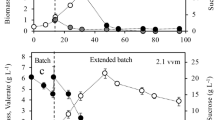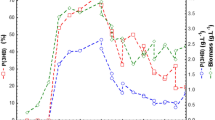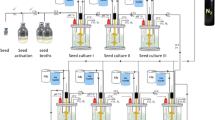Abstract
A mathematically based fed-batch bioprocess demonstrated the suitability of using a relatively cheap and renewable substrate (butyric acid) for Pseudomonas putida CA-3 high cell density cultivation. Butyric acid fine-tuned addition is critical to extend the fermentation run and avoid oxygen consumption while maximising the biomass volumetric productivity. A conservative submaximal growth rate (μ of 0.25 h−1) achieved 71.3 g L−1 of biomass after 42 h of fed-batch growth. When a more ambitious feed rate was supplied in order to match a μ of 0.35 h−1, the volumetric productivity was increased to 2.0 g L−1 h−1, corresponding to a run of 25 h and 50 g L−1 of biomass. Both results represent the highest biomass and the best biomass volumetric productivity with butyrate as a sole carbon source. However, medium chain length polyhydroxyalkanoate (mcl-PHA) accumulation with butyrate grown cells is low (4 %). To achieve a higher mcl-PHA volumetric productivity, decanoate was supplied to butyrate grown cells. This strategy resulted in a PHA volumetric productivity of 4.57 g L−1 h−1 in the PHA production phase and 1.63 g L−1 h−1over the lifetime of the fermentation, with a maximum mcl-PHA accumulation of 65 % of the cell dry weight.






Similar content being viewed by others
References
Abe H, Ishii N, Sato S, Tsuge T (2012) Thermal properties and crystallization behaviours of medium-chain-length poly(3-hydroxyalkanoate)s. Polymer 53:3026–3034
Albuquerque MGE, Torres MG, Reis MAM (2010) Polyhydroxyalkanoate (PHA) production by a mixed microbial culture using sugar molasses: effect of the influent substrate concentration on culture selection. Water Res 44(11):3419–3433
Aymerich E, Esteban-Gutierrez M, Sancho L (2013) Analysis of the stability of high-solids anaerobic digestion of agro-industrial waste and sewage sludge. Bioresour Technol 144:107–114
Bagdasarian M, Lurz R, Rckert B, Franklin FCH, Bagdasarian MM, Frey J, Timmis KN (1981) Specific-purpose plasmid cloning vectors II. Broad host range, high copy number, RSF 1010-derived vectors, and a host-vector system for gene cloning in Pseudomonas. Gene 16(1–3):237–247
Browne J, Nizami AS, Thamsiriroj T, Murphy JD (2011) Assessing the cost of biofuel production with increasing penetration of the transport fuel market: a case study of gaseous biomethane in Ireland. Renew Sust Energ Rev 15:4537–4547
Casey WT, Nikodinovic-Runic J, Fonseca-Garcia P, Guzik MW, McGrath JW, Quinn JP, Cagney G, Prieto MA, O’Connor KE (2013) The effect of polyphosphate kinase (ppk) deletion on polyhydroxyalkanoate accumulation and carbon metabolism in Pseudomonas putida KT2440. Environ Microbiol Rep 5(5):740–746
Cerrone F, Choudhari S, Davis R, Cysneiros D, O’Flaherty V, Duane G, Casey E, Guzik MW, Kenny TS, Babu PR, O’Connor KE (2014) Medium chain length polyhydroxyalkanoate (mcl-PHA) production from volatile fatty acids derived from the anaerobic digestion of grass. Appl Microbiol Biotechnol 98(2):611–620
Cheung HNB, Huang GH, Yu H (2010) Microbial-growth inhibition during composting of food waste: effects of organic acids. Bioresour Technol 101:5925–5934
Doran PM (1995) Bioprocess engineering principles. Academic, London
Elbahloul Y, Steinbuchel A (2009) Large-scale production of poly (3-hydroxyoctanoic acid) by Pseudomonas putida GPO1 and a simplified downstream process. Appl Environ Microbiol 75(3):643–651
Enfors SO, Häggström L (2000) Bioprocess technology—fundamentals and applications (a textbook for introduction of the theory and practice of biotechnical processes). Royal Institute of Technology (KTH), Stockholm
Forster-Carneiro T, Perez M, Romero LI (2008) Thermophilic anaerobic digestion of source-sorted organic fraction of municipal solid waste. Bioresour Technol 99:6763–6770
Galego N, Rozsa C, Sanchez R, Fung F, Vazquez A, Tomas JS (2000) Characterization and application of poly(β-hydroxyalkanoates) family as composite biomaterials. Polym Test 19:485–492
Grousseau E, Blanchet E, Déléris S, Albuquerque MGE, Etienne P, Uribellarea JL (2013) Impact of sustaining a controlled residual growth on polyhydroxybutyrate yield and production kinetics in Cupriavidus necator. Bioresour Technol 148:30–38
Grousseau E, Blanchet E, Déléris S, Albuquerque MGE, Etienne P, Uribellarea JL (2014) Phosphorus limitation strategy to increase propionic acid flux towards 3-hydroxyvaleric acid monomers in Cupriavidus necator. Bioresour Technol 153:206–215
Johnson EL, Hyman MR (2006) Propane and n-butane oxidation by Pseudomonas putida GPo1. Appl Environ Microbiol 72(1):950–952
Kenny ST, Nikodinovic J, Babu RP, Woods T, Blau WJ, O’Connor KE (2008) Up-cycling of PET (polyethylene terephthalate) to the biodegradable plastic PHA (polyhydroxyalkanoate). Environ Sci Technol 42:7696–7701
Lageveen R, Huisman G, Preusting H, Witholt B (1988) Formation of polyesters by Pseudomonas oleovorans: effect of substrates on formation and composition of poly-(R)-3-hydroxyalkanoates and poly-(R)-3-hydroxyalkanoates. Appl Environ Microbiol 54(12):2924–2932
Lee SY, Wong HH, Choi J, Lee SH, Lee SC, Han CS (2000) Production of medium-chain-length polyhydroxyalkanoates by high-cell-density cultivation of Pseudomonas putida under phosphorus limitation. Biotechnol Bioeng 68:466–470
Lehtomaki A, Huttunen S, Lehtinen TM, Rintala JA (2008) Anaerobic digestion of grass silage in batch leach bed processes for methane production. Bioresour Technol 99:3267–3278
Levenberg K (1944) A method for the solution of certain non-linear problems in least squares. Q Appl Math II 2(1):164–168
Maclean H, Sun ZY, Ramsay J, Ramsay B (2008) Decaying exponential feeding of nonanoic acid for the production of medium-chain-length poly(3-hydroxyalkanoates) by Pseudomonas putida KT2440. Can J Chem-Rev Can Chim 86(6):564–569
Matsuyama A, Yamamoto H, Kawada N, Kobayashi Y (2001) Industrial production of _R/-1,3-butanediol by new biocatalysts. J Mol Catal B Enzym 11:513–521
Muhr A, Rechberger EM, Salerno A, Reiterer A, Malli K, Strohmeier K, Schober S, Mittlebach M, Koller M (2013) Novel description of mcl-PHA biosynthesis by Pseudomonas chlororaphis from animal-derived waste. J Biotechnol 165(1):45–61
Neves L, Oliveira R, Alves MM (2009) Co-digestion of cow manure, food waste and intermittent input of fat. Bioresour Technol 100:1957–1962
Ng KS, Wong YM, Tsuge T, Sudesh K (2011) Biosynthesis and characterization of poly (3-hydroxybutyrate-co-3-hydroxyvalerate) and poly (3-hydroxybutyrate-co-3-hydroxyhexanoate) copolymers using jatropha oil as the main carbon source. Process Biochem 46:1572–1578
Nielsen J, Villadsen J (1992) Modelling of microbial kinetics. Chem Eng Sci 47(17–18):4225–4270
O’Connor K, Buckley CM, Hartmans S, Dobson ADW (1995) Possible regulatory role for nonaromatic carbon sources in styrene degradation by Pseudomonas putida CA-3. Appl Environ Microbiol 61:544–548
Patterson T, Esteves S, Dinsdale R, Guwy A (2011) An evaluation of the policy and techno-economic factors affecting the potential for biogas upgrading for transport fuel use in the UK. Energ Policy 39(3):1806–1816
Philp JC, Ritchie RJ, Guy K (2013) Biobased plastics in a bioeconomy. Trends Biotechnol 31(2):65–67
Poblete-Castro I, Becker J, Dohn K, Martins dos Santos V, Wittmann C (2012) Industrial biotechnology of Pseudomonas putida and related species. Mini review. Appl Microbiol Biotechnol 93:2279–2290
Rehm BHA, Mitsky TA, Steinbuchel A (2001) Role of fatty acid de novo biosynthesis in polyhydroxyalkanoic acid (PHA) and rhamnolipid synthesis by pseudomonads: establishment of the transacylase (PhaG)-mediated pathway for PHA biosynthesis in Escherichia coli. Appl Environ Microbiol 67:3102–3109
Ren Q, Ruth K, Thny-Meyer L, Zinn M (2010) Enantiomerically pure hydroxycarboxylic acids: current approaches and future perspectives. Mini-Review. Appl Microbiol Biotechnol 87(1):41–52
Roels JA (1983) Energetics and kinetics in biotechnology. Elsevier Biomedical, Amsterdam
Selvam A, Xu SY, Gu XY, Wong JWC (2010) Food waste decomposition in leachbed reactor: role of neutralizing solutions on the leachate quality. Bioresour Technol 101:1707–1714
Sudheesh N, Parmar JN, Shukla RS (2012) Hydroformylation of propene heterogeneously catalyzed by HRh(CO)(PPh3)3 encapsulated into hexagonal mesoporous silica—parametric variation and mass transfer study. Appl Catal A Gen 415–416:124–131
Sun Z, Ramsay JA, Guay M, Ramsay BA (2007) Carbon-limited fed-batch production of medium-chain-length polyhydroxyalkanoates from nonanoic acid by Pseudomonas putida KT2440. Appl Microbiol Biotechnol 74:69–77
Sun Z, Ramsay JA, Guay M, Ramsay BA (2009) Enhanced yield of medium-chain-length polyhydroxyalkanoates from nonanoic acid by co-feeding glucose in carbon-limited, fed-batch culture. J Biotechnol 143(4):262–267
Tobin KM, McGrath JW, Mullan A, O’Connor KE (2007) Polyphosphate accumulation by Pseudomonas putida CA-3 and other medium chain length polyhydroxyalkanoate accumulating bacteria under aerobic growth conditions. Appl Environ Microbiol 73:1383–1387
Vantriet K (1979) Review of measuring methods and results in nonviscous gas-liquid mass-transfer in stirred vessels. Ind Eng Chem Process Des Dev 18(3):357–364
Vrana Špoljaric I, Lopar M, Koller M, Muhr A, Salerno A, Reiterer A, Malli K, Angerer H, Strohmeier K, Schober S, Mittelbach M, Horvat P (2013) Mathematical modeling of poly[(R)-3-hydroxyalkanoate] synthesis by Cupriavidus necator DSM 545 on substrates stemming from biodiesel production. Bioresour Technol 133:482–494
Wittgens A, Tiso T, Arndt TT, Wenk P, Hemmerich J, Müller C, Wichmann R, Küpper B, Zwick M, Wilhelm S, Hausmann R, Syldatk C, Rosenau F, Blank LM (2011) Growth independent rhamnolipid production from glucose using the non-pathogenic Pseudomonas putida KT2440. Microb Cell Factories 10:80
Zhang C, Yang H, Yang F, Ma Y (2009) Current progress on butyric acid production by fermentation. Curr Microbiol 59:656–663
Zhu Y, Wu Z, Yang ST (2002) Butyric acid production from acid hydrolysate of corn fibre by Clostridium tyrobutyricum in a fibrous-bed bioreactor. Process Biochem 38:657–666
Acknowledgments
Federico Cerrone was funded by Enterprise Ireland and the Irish Industrial Development Agency (IDA) through the Technology Center for Biorefining and Bioenergy (project no. CC20090004). The authors have no conflict of interest to declare.
Author information
Authors and Affiliations
Corresponding author
Electronic supplementary material
Below is the link to the electronic supplementary material.
ESM 1
(PDF 143 kb)
Rights and permissions
About this article
Cite this article
Cerrone, F., Duane, G., Casey, E. et al. Fed-batch strategies using butyrate for high cell density cultivation of Pseudomonas putida and its use as a biocatalyst. Appl Microbiol Biotechnol 98, 9217–9228 (2014). https://doi.org/10.1007/s00253-014-5989-8
Received:
Revised:
Accepted:
Published:
Issue Date:
DOI: https://doi.org/10.1007/s00253-014-5989-8




